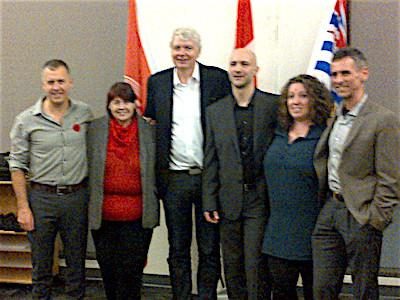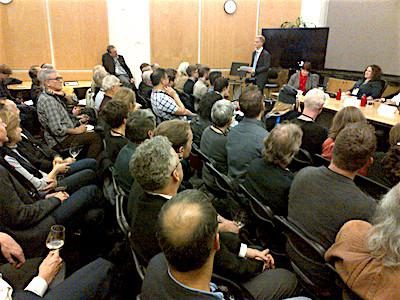On Thursday November 10th, the Architectural Institute of B.C. held its first passive house event, centering on their gallery presentation of Passive House projects in B.C. This opening reception included a moderated panel discussion on green building and Passive House technology.
As with previous Passive House events that I have been to in this city, the room was packed with a range of interested stakeholders, including architects, engineers, designers, city planners and suppliers. There was definitely a buzz in the air for this event!
The panel was well moderated and the questions very pertinent. Listening to the answers from the builders and architects on how they make a business case for building to Passive House standards, it struck me how much this program should be adopted by the province. All of the answers essentially stated that it was the right way to build, and that anything less is really just cutting corners. If the city were to adopt Passive House as the standard, there are a variety of ways to achieve this but they all require forethought and planning and a little more upfront cost. If everyone were doing this, the question wouldn’t be “why is this costing me more?” but it would be “why am I not getting the performance for the money I’m spending?” It wouldn’t be about getting the lowest priced building built, but rather the highest performing for the money spent like many products of quality.
In fact, taking this a step further, one can easily see that the B.C. government spending $9billion+ on a dam is a waste of financial resources. If that money (or even a portion of it) were to be put towards establishing the Passive House standard for construction in B.C., the economy, industry and the environment would be better off overall. The money could be put into policy, engagement, education, innovation and new initiatives that would continue to pay off down the road for a much longer time than a dam will. The number of jobs that would be created would be far greater, and B.C. would end up being a leader and net exporter of their innovations and knowledge to the world!
At least the City of Vancouver is recognizing the Passive House standard in building applications and making special allowances for this type of construction. In general for the future, the CoV is focusing on GHG emissions, as well as indoor air quality, which bodes very well for hempcrete. It is a carbon-negative building material, as well as non-toxic and very healthy, so I hope to see some hempcrete projects coming to the city soon.



HELLO,
please I need molds to make this type of bricks
Hello Abuelias, what type of bricks do you want to make? There are a number of different options, but it depends on your end goal. Mostly though, you will likely need to make your own molds, which is not too difficult.